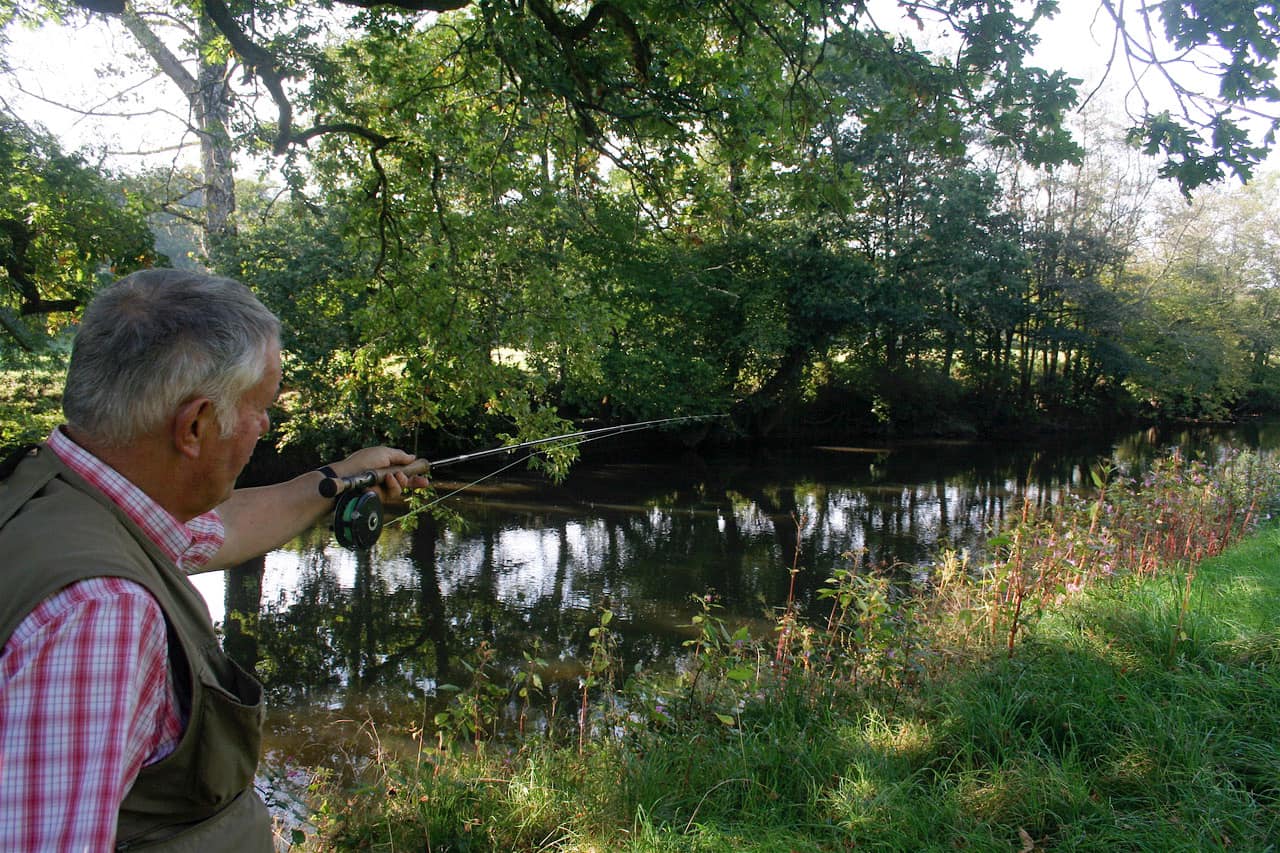
GRAND OPENING/BLACK FRIDAY SALE Friday 29th/Saturday 30th November
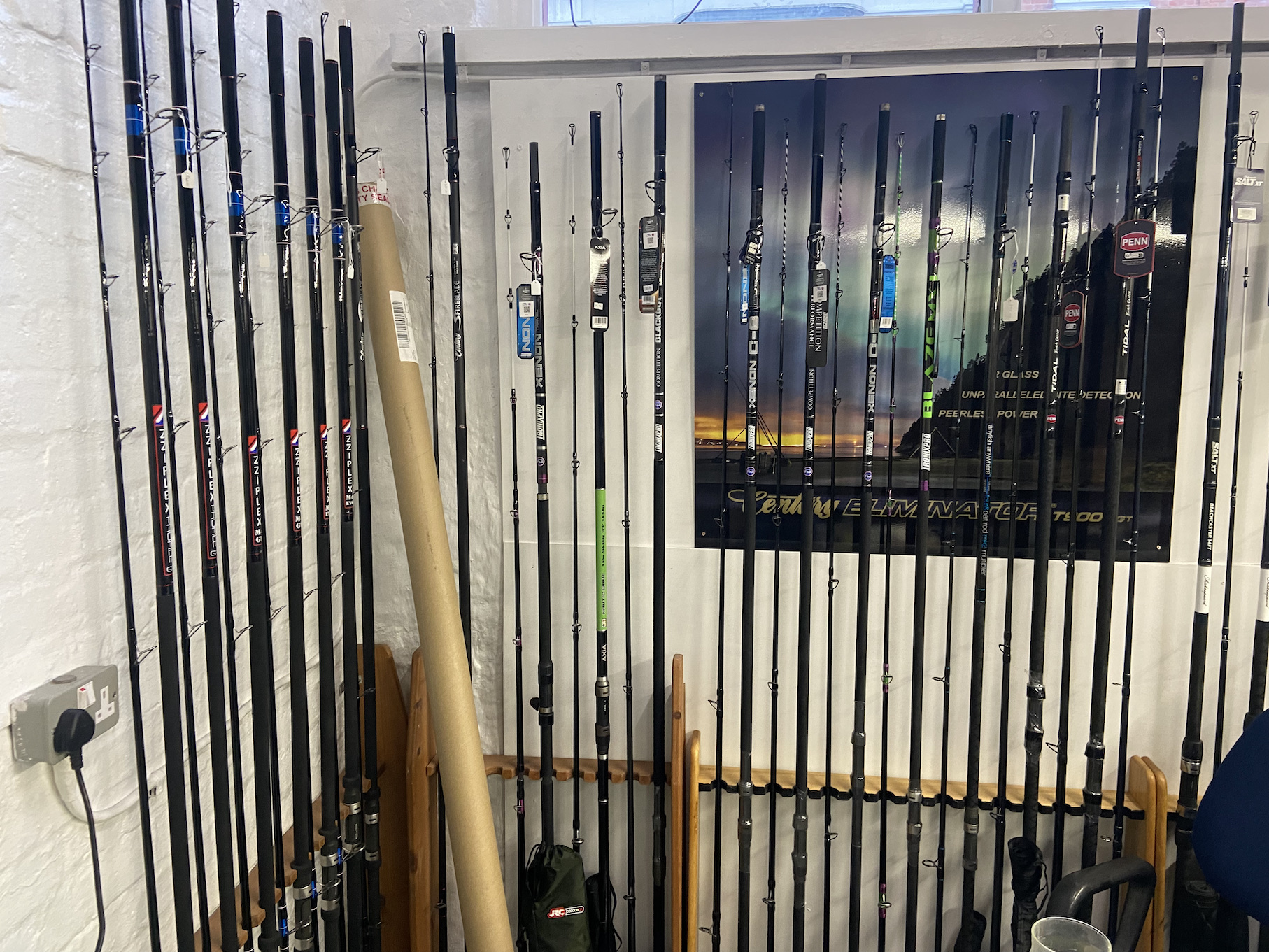


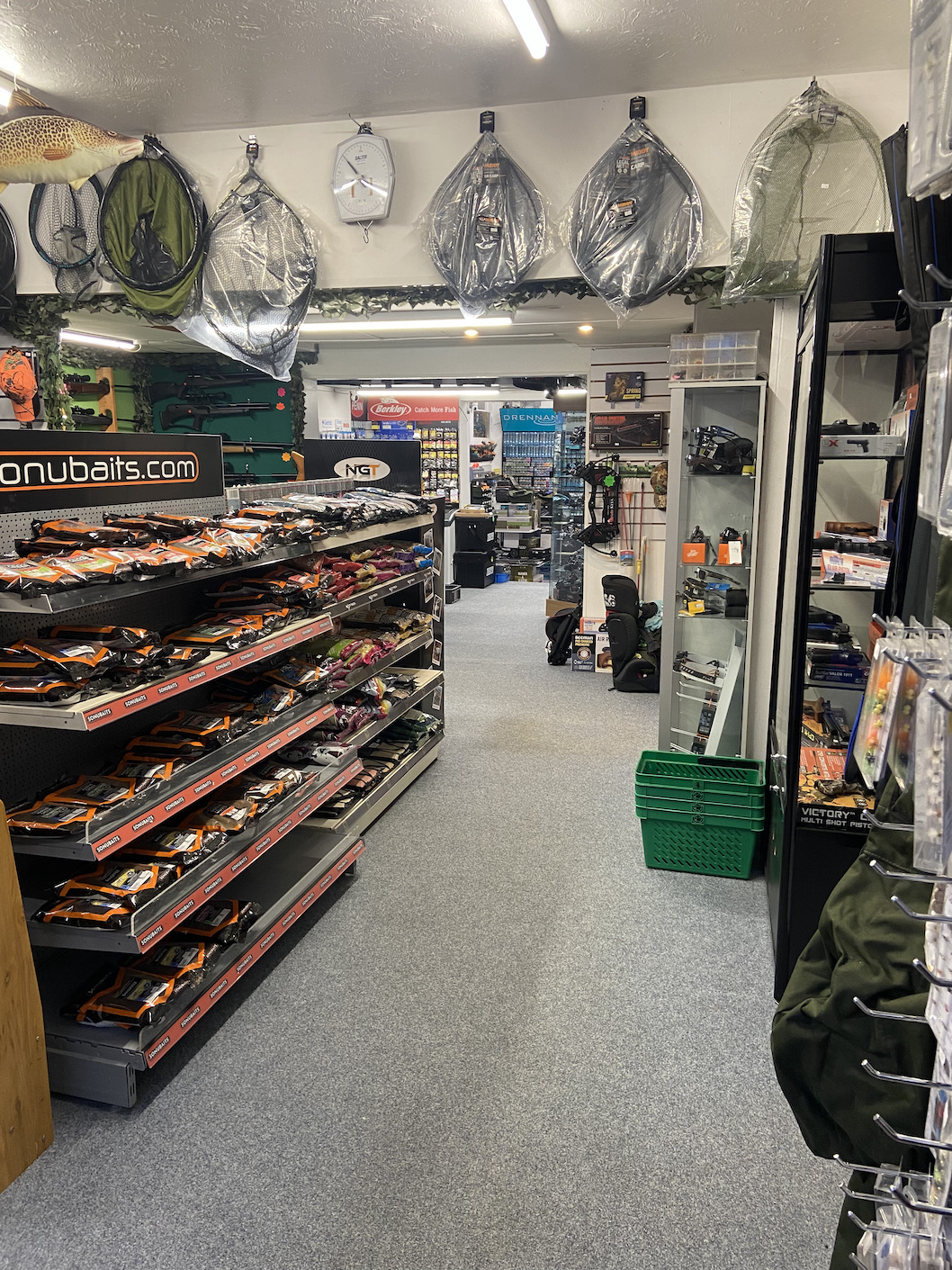



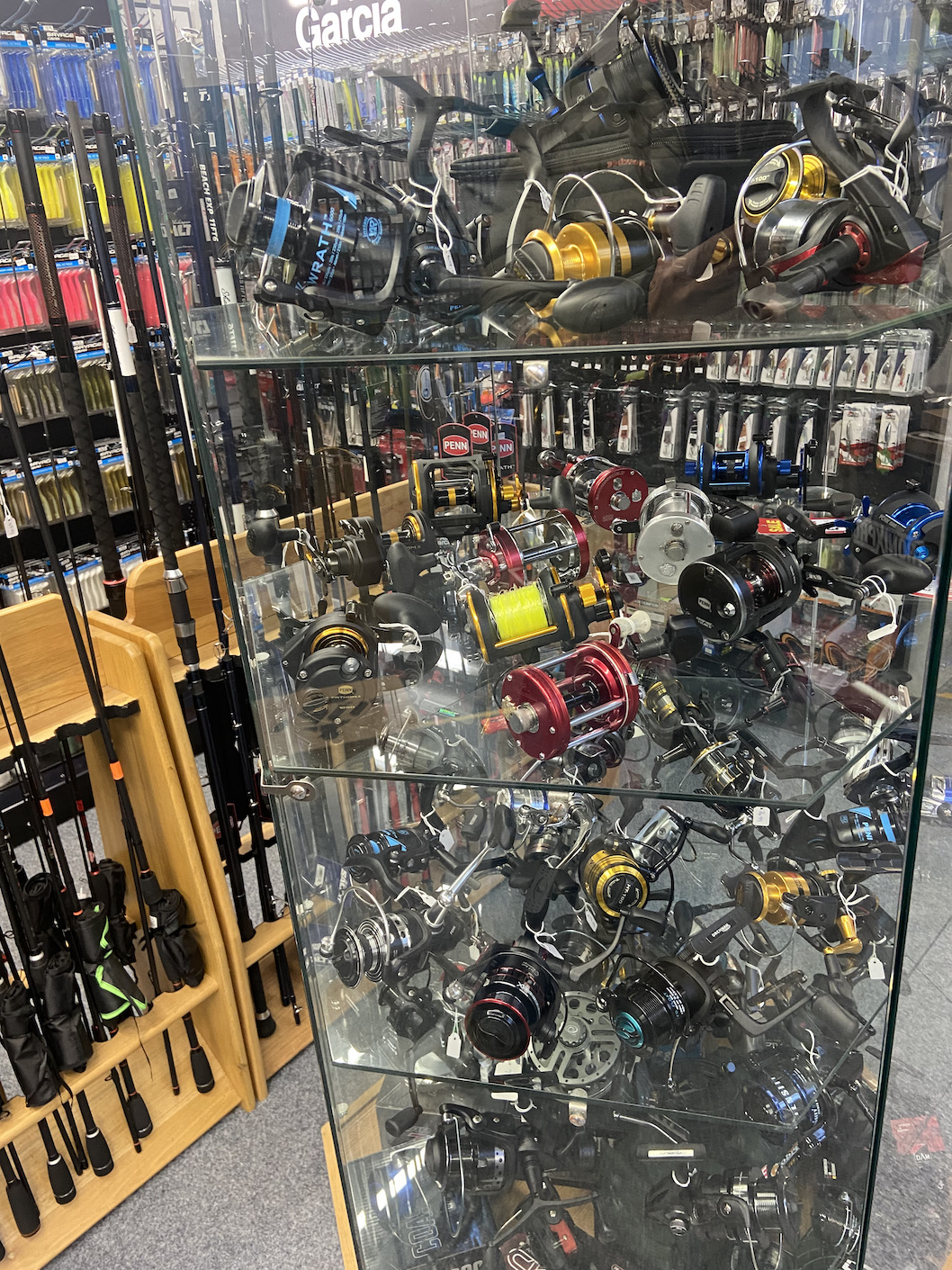
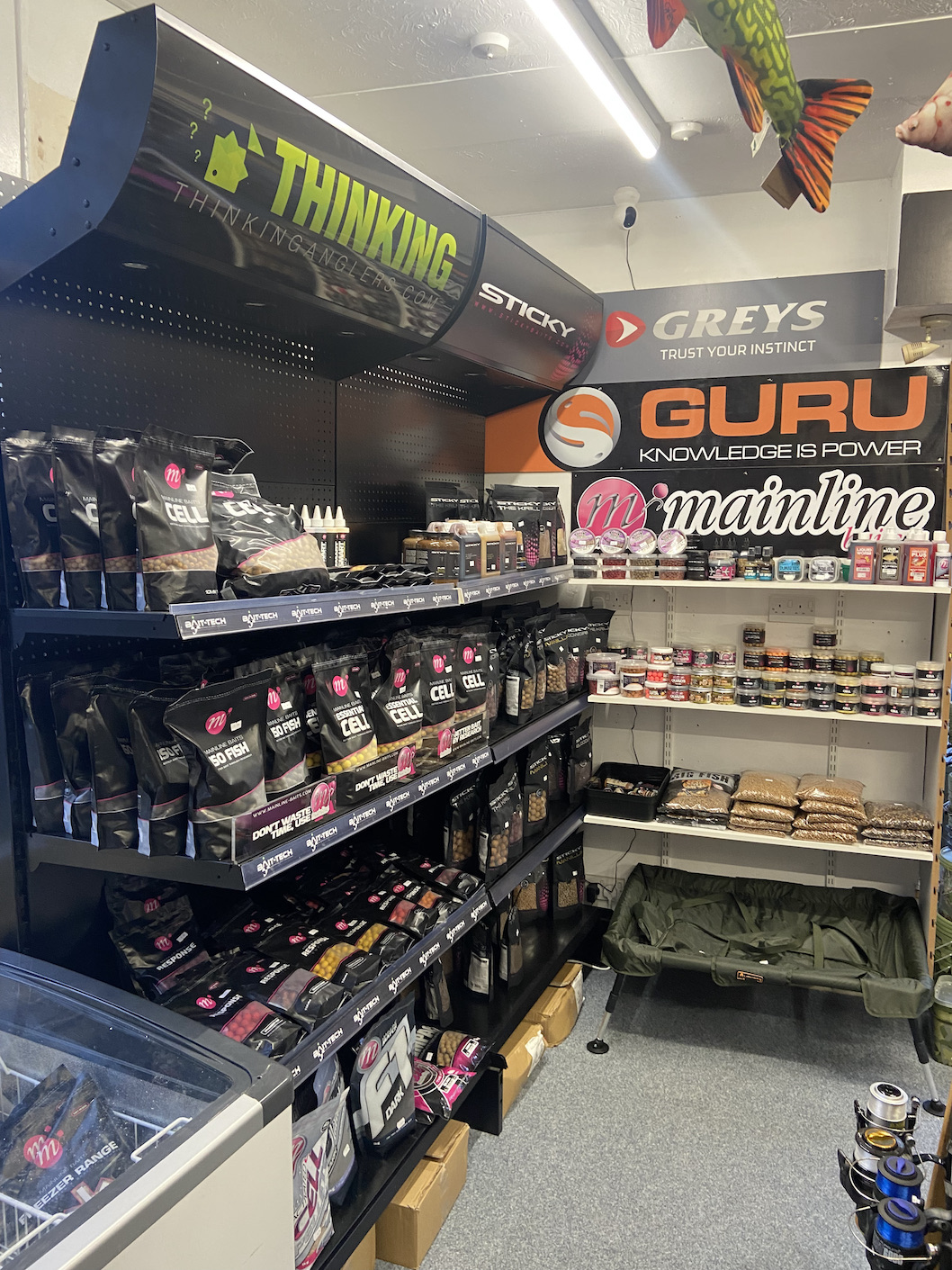
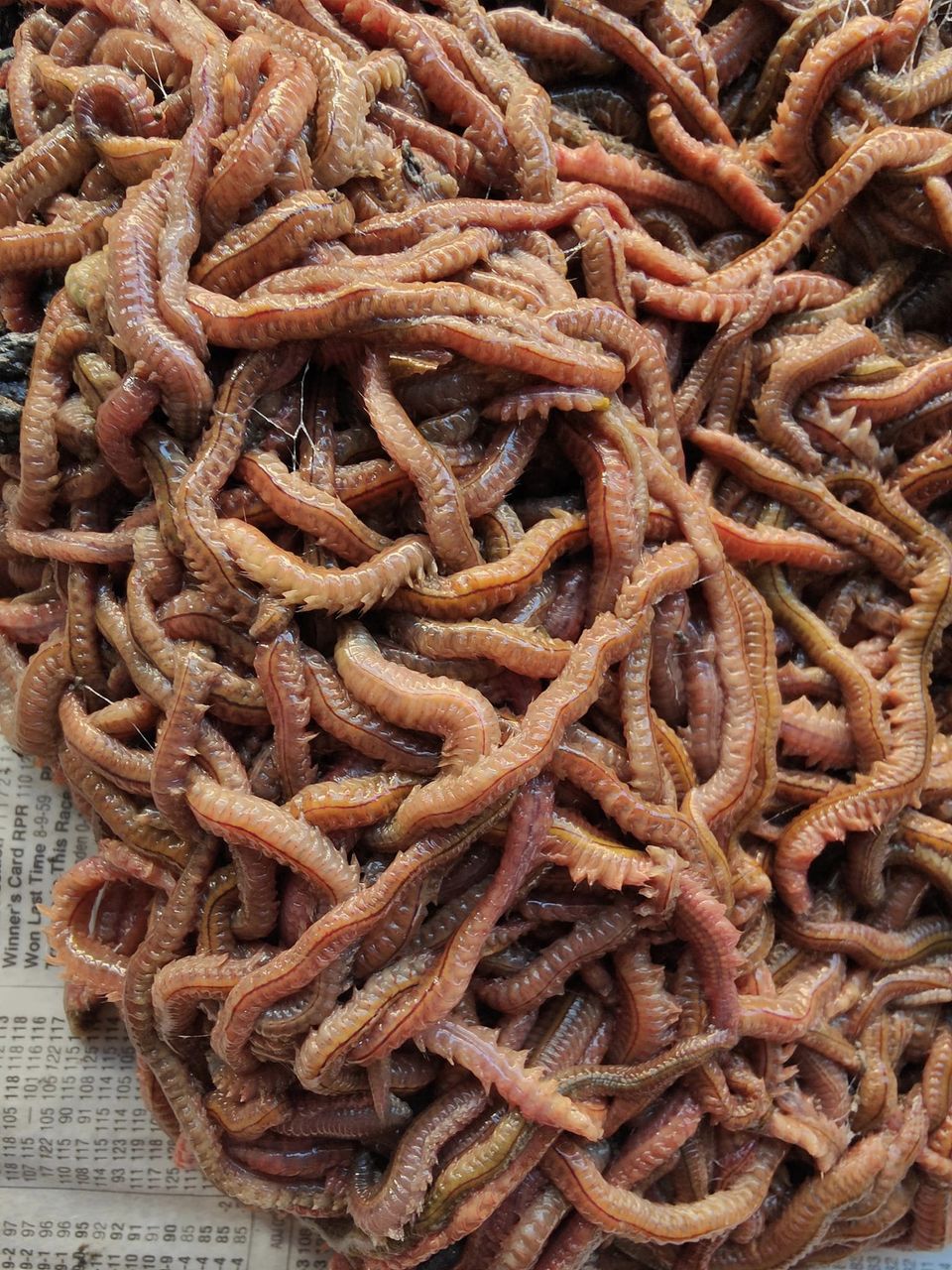
















Nick Philips took first and second place in Combe Martin SAC’s annual flounder competition tempted flounder of 1lb 4oz and 1lb 3oz. Lenny Lake was third with a flounder of 1lb 1oz. Several bass were also caught the best around 3lb.




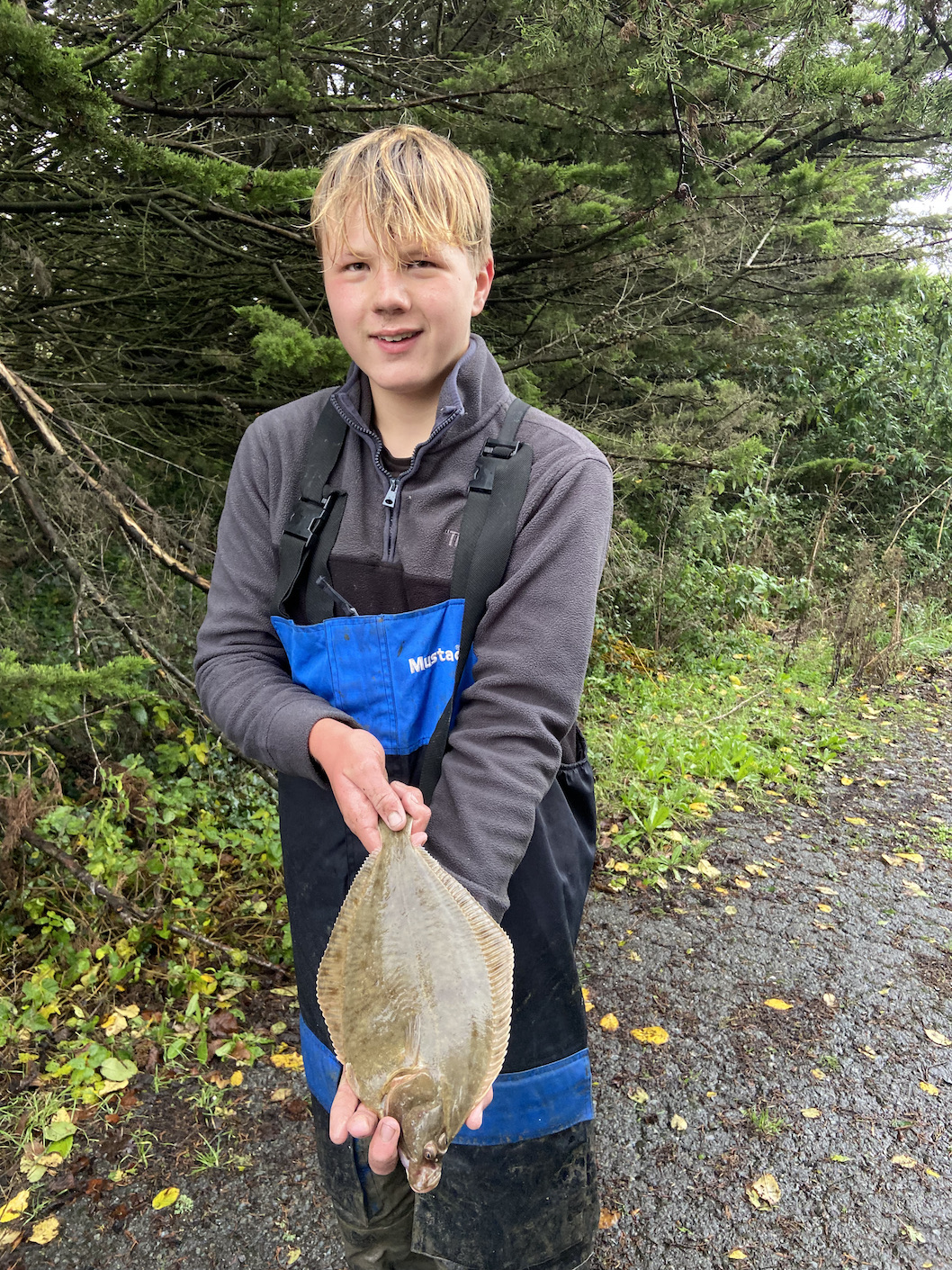




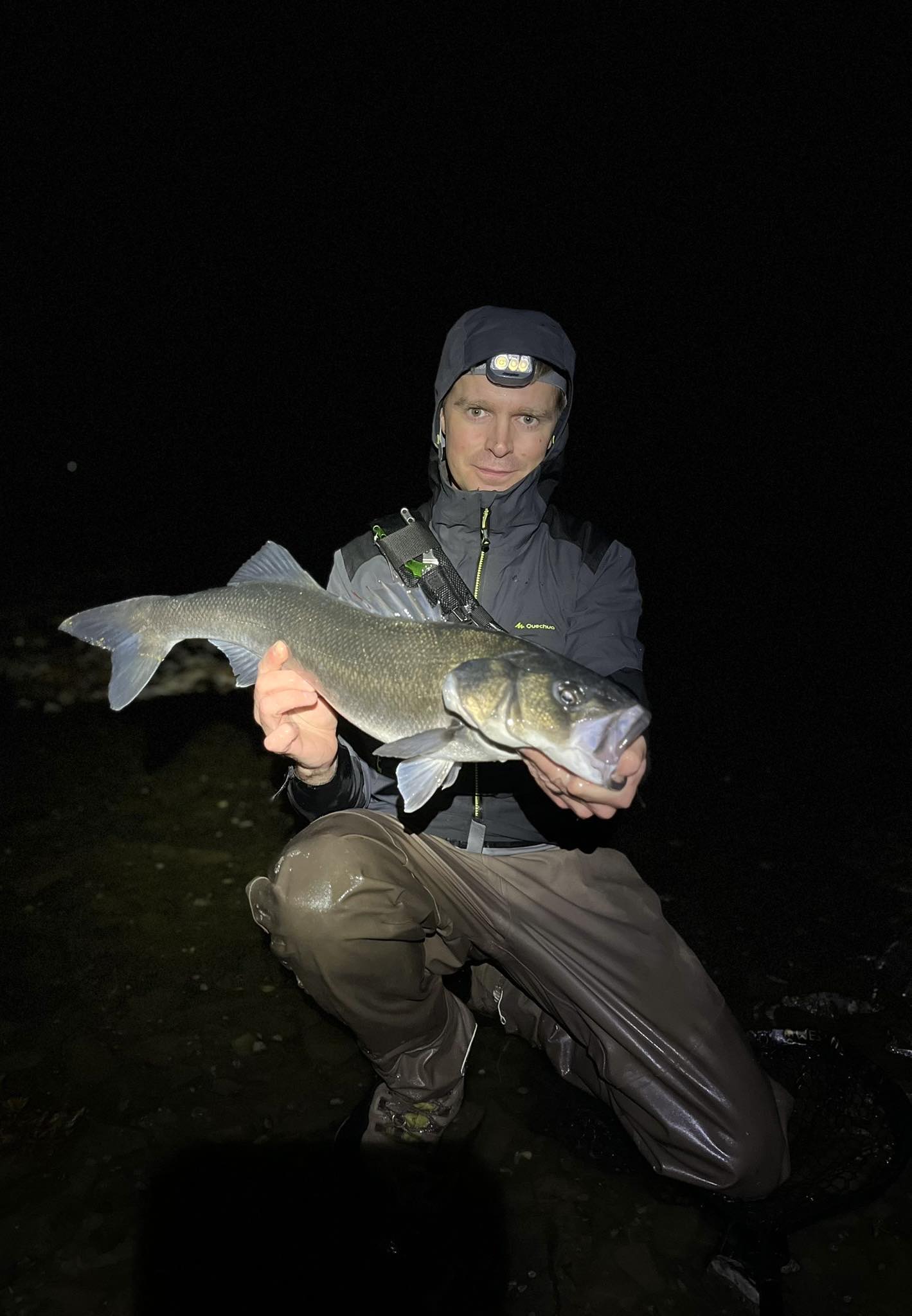
I asked Reece about his go to lures and two of his top three are pictured below.
The megabass Dark sleeper and Megabass AYU 5″ Spindleworms certainly deserve a place in any keen lure fishers lure box.

Lure fishing is certainly a fascinating branch of angling with many thousands of lures available. Danny stocks an impressive range of lures to cover every aspect and species within the UK and beyond.

Runner up in the lure competition was Wayne Thomas with five bass for 310 cm, Ross Stanway with five for 293cm and Dan Welch with five for 270cm.
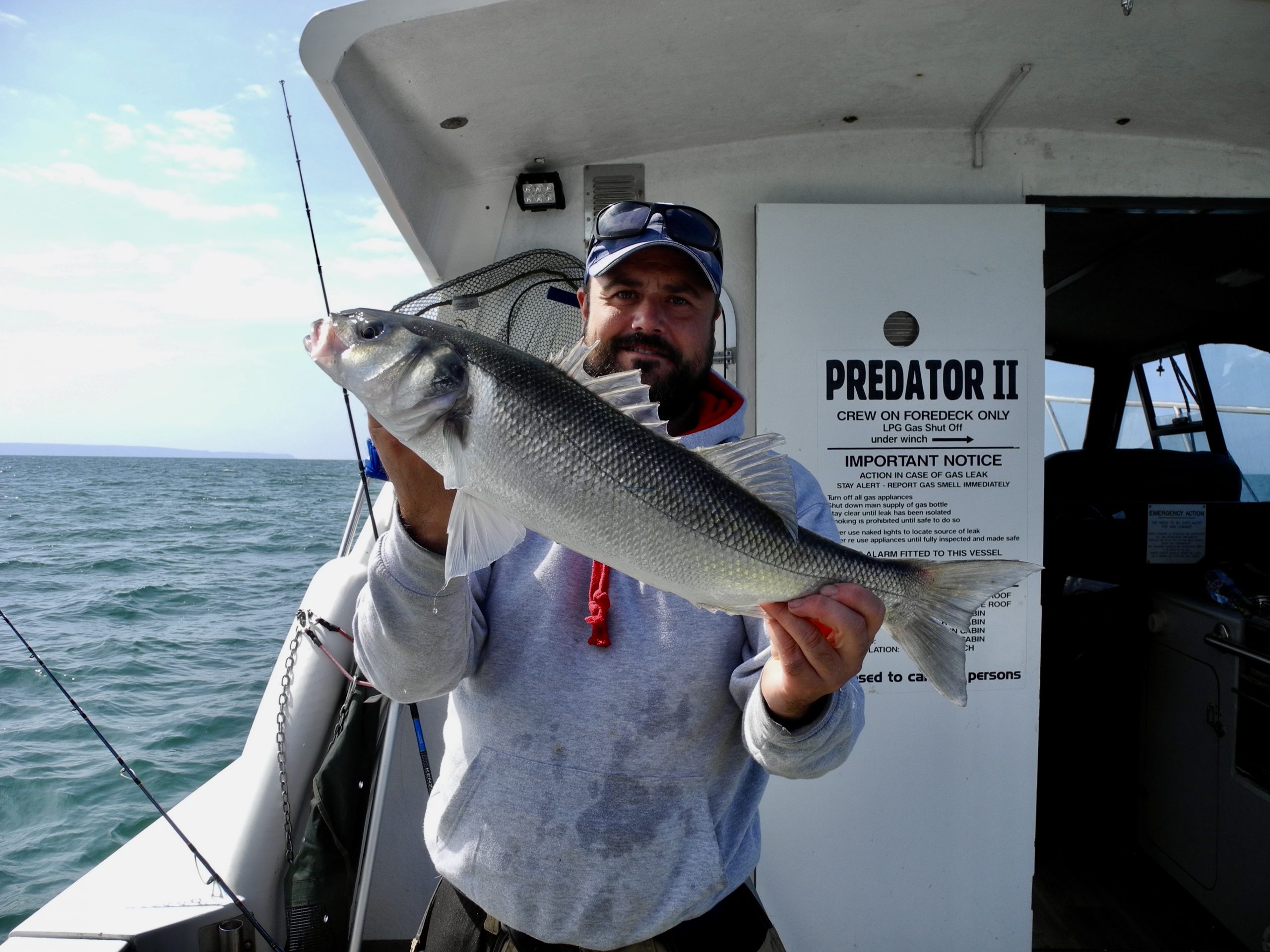

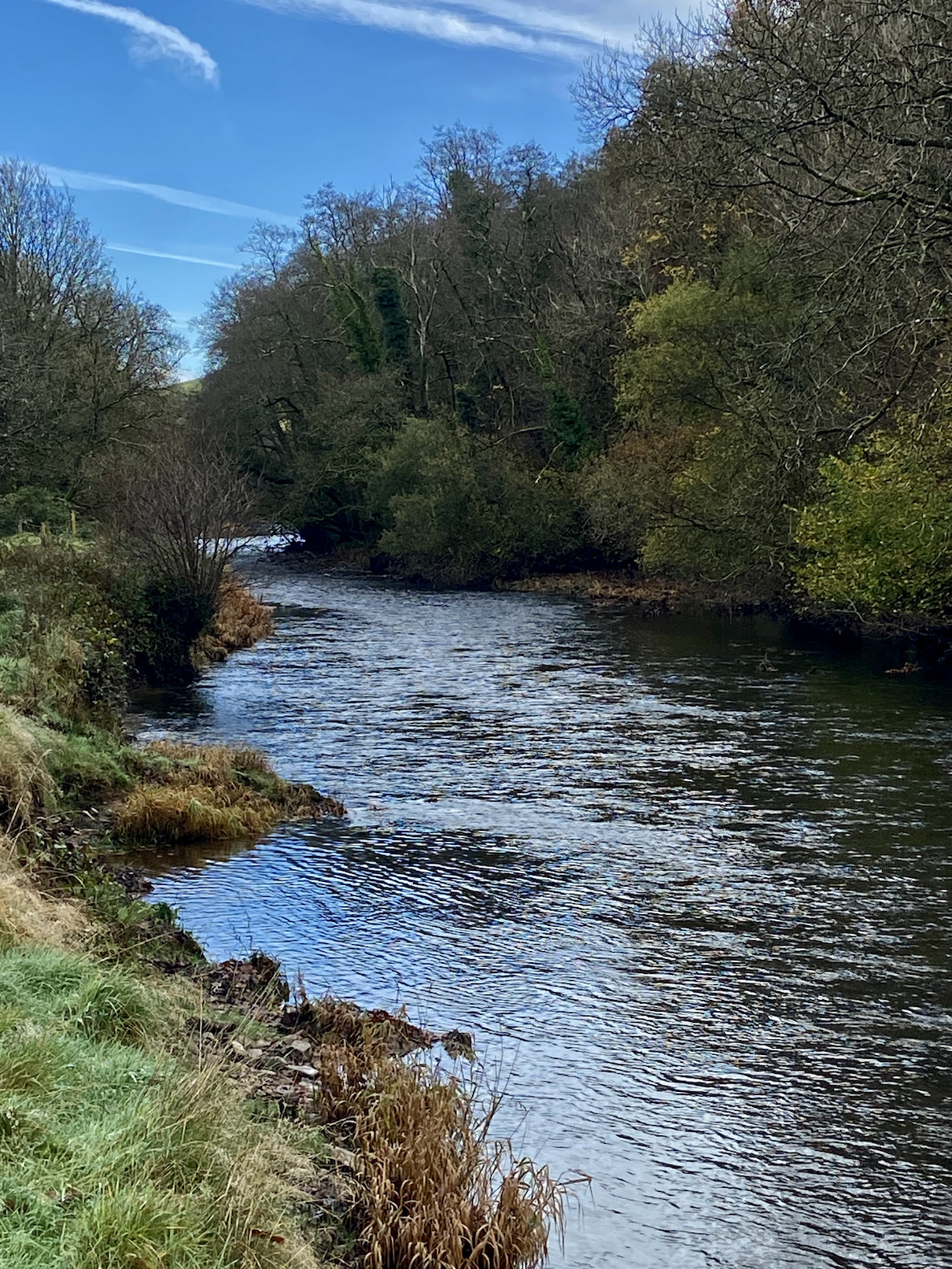
Grayling known as the ladies of the stream are not abundant in the rivers of the South West. A long established population thrives in the River Exe and some of its tributary’s and I enjoyed a day fishing one of Dulverton Angling Associations beats below Dulverton. The river was running low and clear and I was confident of success as I searched the river. After four hours of searching I failed to stimulate any interest from the elusive grayling and left the river as rain started to fall.

As always time at the water’s edge is never wasted and I was privileged to catch sight of a kingfisher as it perched upon an overhanging branch. An egret also flew past looking quite surreal in the stark winter landscape. Dippers, wrens and ducks also graced the river and its banks. The glorious colours of late Autumn decorated the banks as the river flowed relentlessly to the sea.





Barnstaple & District Angling Clubs AGM was held at the Ebberley Arms in Barnstaple with a very good proportion of the membership in attendance. The clubs committee are undoubtedly a hard-working and dedicated team full of optimism despite difficult times on the river.
The club has purchased a new stretch of fishing on the Middle Taw that was for many years owned by John Saunders affectionately known to local anglers as ‘Gandy’. Sadly no salmon were landed from the beat this year. Fortunately the wild brown trout fishing was superb with plenty of stunning fish over 1lb caught.
Alan Jump works tirelessly working to enhance South Aller Lake the clubs sole remaining coarse fishing lake. The lake offers excellent fishing for tench, crucian carp, roach, perch, eels and carp to mid doubles. The secluded lake set in an old quarry surrounded by mature trees is a wildlife haven far removed from some of today’s commercial lakes with their platforms and gravel paths.
Don Hearn gave a passionate and detailed report on the clubs fishing at Newbridge. Three salmon were caught from the beat this year one of the worst in living memory. There were positive reports of roach and dace being caught from the club water which is an encouraging sign as the river was once a thriving coarse fishery renowned across the country for producing huge roach many of them over 2lb.
The numbers of shad entering the river is of great interest to scientists and the presence of these fish is likely to offer conservation funding and protection for this iconic North Devon river.
The official proceedings were followed by fascinating talks from Lucy Robinson and Mike McNally both from the Devon and Cornwall Police Wildlife Team. Mike and Lucy explained how important all information is and how it can be used to piece together the complex and intricate jigsaw puzzle of crime detection.
The illegal netting of elvers was a fascinating part of the talk with the massive value of these fascinating fish fuelling a vast criminal network that exports to the Far-East.
Sadly the Wildlife Crime department is underfunded as is the Environment Agency and other regulatory bodies that try to protect our natural world.
In this day and age poachers have sophisticated technology at their disposal such as thermal imaging that can target a deer at over mile distance.
Reporting of incidents is 100% anonymous and can be reported via Crime Stoppers 0800 555111 Crimestoppers-uk.org
To report pollution incidents call the EA on 0800 807060

DON HEARNS – Report
A difficult year for all game rivers it seems and no exception on the Taw.

We started the season with a first day meet and BBQ at the new club hut in a hail shower! A good number attended though, including Gary Herbert who drove all the way from Guildford for it. Good effort and despite the weather a brilliant social occasion enjoyed by all who came. Hopefully we can repeat this event next year. Game fishing can be a solitary affair and sharing tall tales of days gone by with like-minded people is always worthwhile as it keeps us all in contact with each other and is one of the reasons our club life is so appreciated.
We start the season full of hope, as ever, but had little reward after the spring.
A few Salmon and sea trout were caught/lost early on but little showed after June. The summer of course was low water and plagued with algae blooms as ever. We did see fish moving up in the last week of September in the spate and assume they went straight upriver. As in previous years the rain came too late for us and that seems to be the pattern these days. There is much discussion as to why so few fish are seen and the more we discuss the more complex it becomes. I had a report from the Tamar, which is a monitored river, that the return of fish was very low. It’s assumed something is happening at sea. Not sure if that is the case but it seems the west country is suffering more than the East coast. Super trawlers, climate change to gulf stream, dirty rivers or maybe a combination of everything. We haven’t had any late season sea trout reported either. I and others spent many nights on several Taw beats without a sign of one, so it wasn’t down to of lack of effort. The only thing for sure is that there is always a chance of a fish and nobody ever caught one watching the T.V.!
It has been noted that the Brownies seem to be doing ok with several fish in the 2lb to 3lb range being reported and many members have scaled down to enjoy good sport with them. More brownies have been reported than ever before in recent times and often save a blank which is welcome. The Shad showed again early in the season and are of great interest as it’s another important protected species and reports of any captures are welcomed as it helps in the fight for our water quality. The recent industrial farming introduced into the Lower Taw valley is putting a lot of pressure on an already troubled river and hopefully there is a way to make it more acceptable. The EA farm inspectorate are investigating this process and we can but hope it can make a difference.
The Southwest rivers trust have asked us for permission to install water monitoring equipment on our waters and of course we welcome it and will assist them all we can. We are not sure where it will be at the moment, but we’ll keep you all posted. If you do find telemetry in the river, please know we are aware and avoid disturbing it. If you haven’t sent in your catch report, please do so even if it’s nil. Please include all species, also an indication of AGM attendance would be helpful.
As most of you know our AGM will be held in the Ebberly Arms, Bear Street, Barnstaple on Tuesday 12th November at 7.30pm. There is free evening parking in the car park at the rear. This is always a friendly social evening, and we are expecting a good attendance as in previous years.
For those struggling with downtime, a reminder that Bass, Mullet and Pike on the fly are always an option and we are lucky enough to have good access locally. We hope you enjoyed your time on the water and wish you tight lines for next season.
Don Hearn
and all at B.D.A.A.

Colin Ashby presenting Dave Winter with the Salmon Trophy
The evening concluded with an auction of fishing books donated by the late John ‘Gandy’ Saunders widow. An amazing £205 was raised has been donated to Devon Air Ambulance.
Several awards were presented including the best salmon of 13lb to Dave Winter.
Steve Maddox was awarded the Claude Pugsley roach cup and Jim Simpkins the bass trophy for a fly caught bass of 5lb. The sea trout trophy was won by Matt Cooper.
After the meeting members enjoyed reflecting upon past glory’s and future aspirations.


I joined with Adrian Bryant and the National Trust at Combe Martin Community Centre to show the acclaimed film Riverwoods to close to fifty attendees. The film was followed by a short presentation by myself on the dramatic decline of salmon in the West Country. National Trust Wetlands Ranger James Thomas lifted sprits with an inspiring presentation on work being undertaken across North Devon to improve wetland habitat and reduce flooding.
The Community Centre was previously the Primary School that I attended as a child back in the late 1960’s. Less than fifty yards from this building the River Umber flows on its journey through the village to the sea. It sad that in those fifty years, (a very short time in the grand scale of nature) the wild brown trout have dwindled dramatically and sea trout are perhaps no longer present. The eels that thrived in the river have also declined alarmingly as they have across the whole of the UK. It is tragic that our generation have overseen this trashing of the natural world.
This was the tenth showing of the Riverwoods Film to audiences across North Devon with over 300 watching the film at various venues. It is to be hoped that our efforts have helped put the health of local rivers higher on the public and political agenda. Keep up to date on North Devon Angling News for future events


Novembers weather so far has been exceptionally benign and settled with high pressure, light winds and mild temperatures.
I Arrived at Bulldog Fishery to join fellow members of Wistlandpound Club for the first heat of their Winter challenge series and was encouraged to see anglers already there enjoying sport with rods bending as good sized rainbow trout were undoubtedly feeding.

It was good to catch up with fishery owner Nigel Early who was as always bubbling with enthusiasm as he chatted about the fishery and future plans.
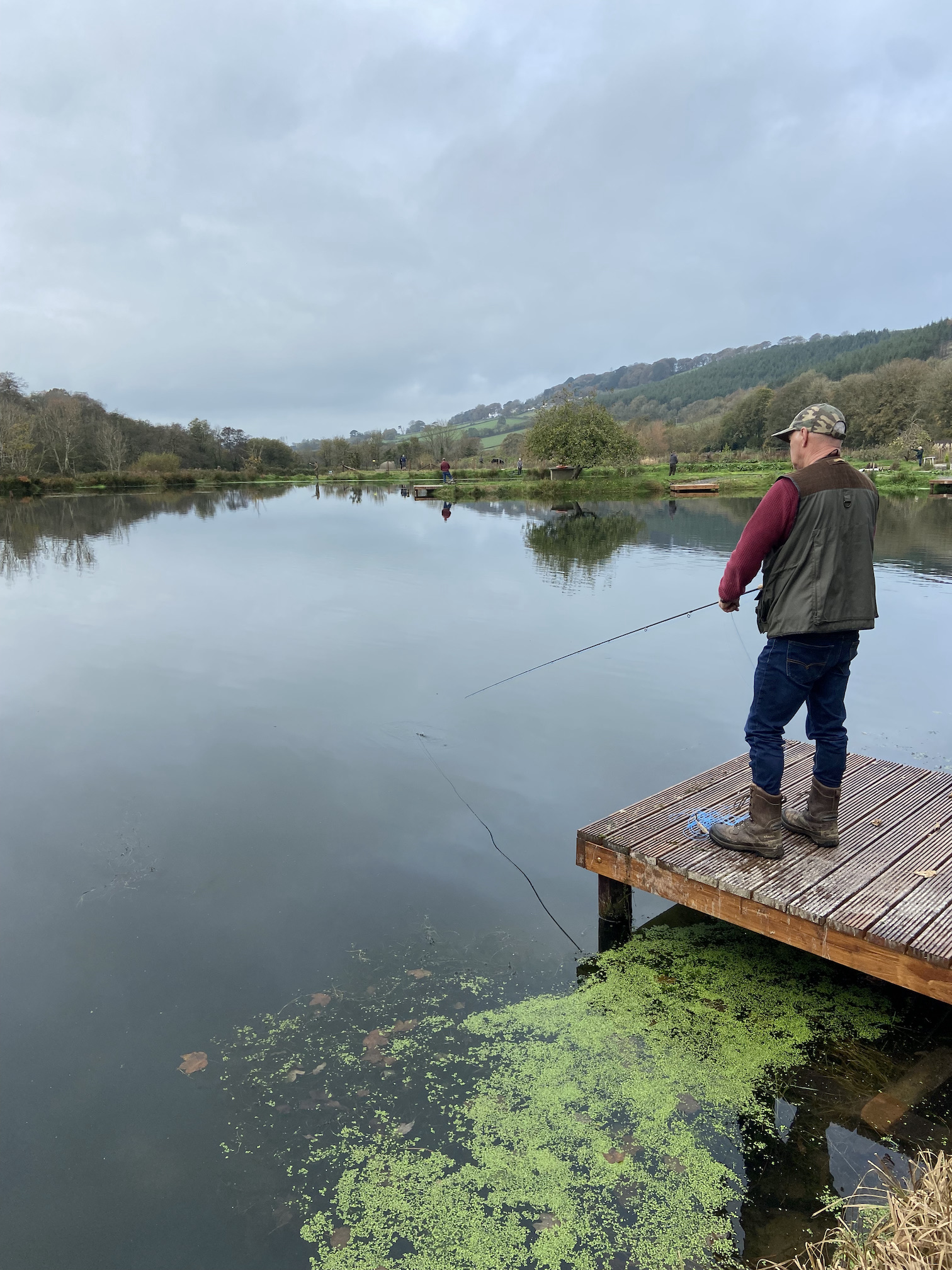
The enlarged trout lake can comfortably fish up to a dozen anglers and has easy access with several fishing platforms that have had overhanging trees pruned to make casting easier. Nigel is keen to encourage visiting groups to make use of this excellent venue that has a comfortable fishing lodge overlooking the lake. I was fascinated to study the cast of a rainbow trout weighing 25lb 3oz that was supplied by Bulldog and held the Welsh Record.
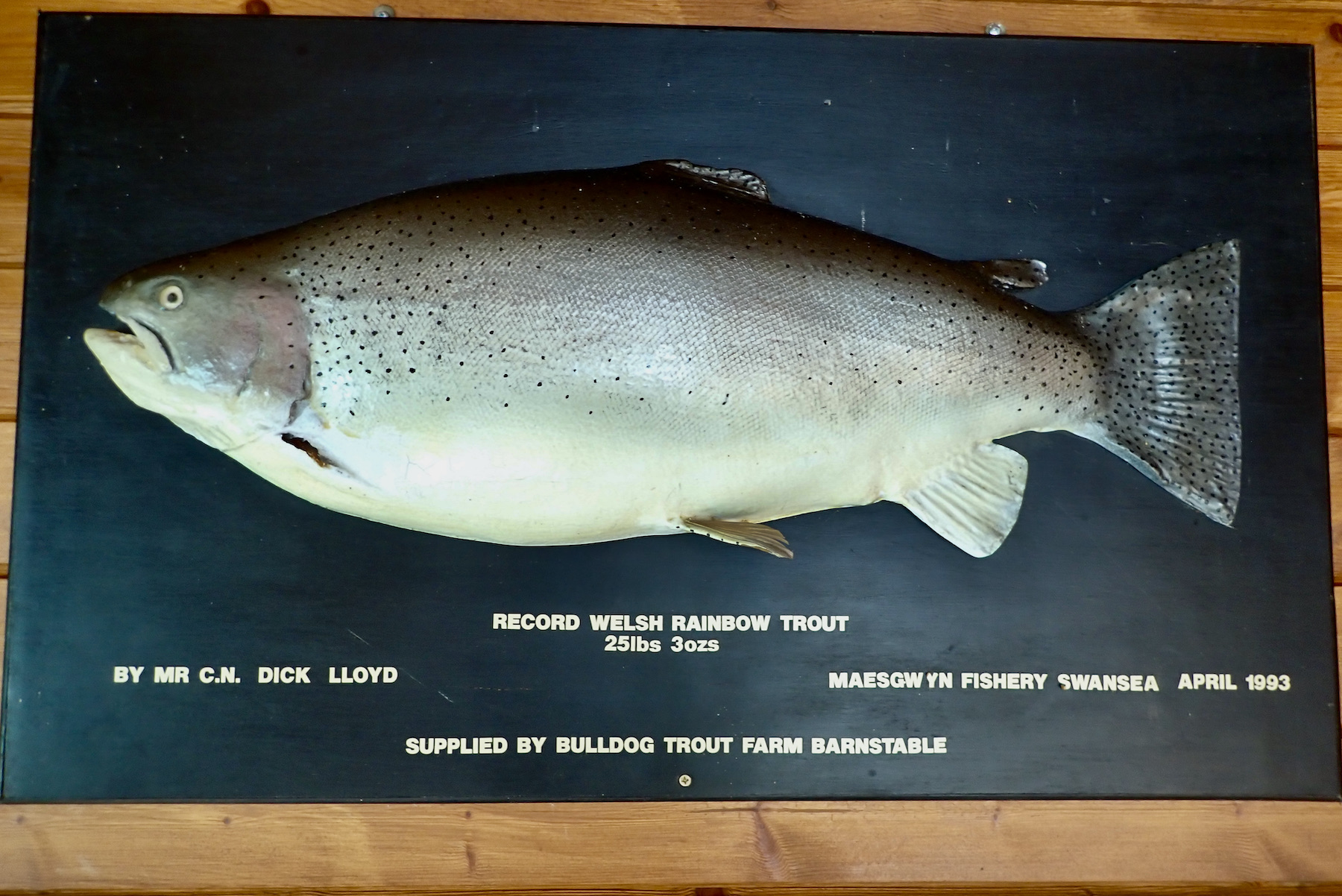

I caught up with fellow club members as we tackled up before heading out to the calm waters.
I had set up with a floating line in conjunction with a relatively long leader of 8lb b.s fluorocarbon to the end of which I had tied my trusted gold headed damsel nymph. I have great faith in this pattern that sinks slowly its marabou tail adding life as it is retrieved.
I headed to the riverside bank and started to search the water allowing the lure to sink before starting a slow erratic retrieve watching the tip of the fly line intently.
After twenty minutes or so I felt a gentle tug transmitted through the line and watched as a trout followed the lure nipping the tail but failing to nail it. Encouraged I recast and after pulling a yard of line felt that satisfying connection as a good sized rainbow devoured the lure.
A spirited tussle was successfully concluded and the trout despatched. It’s always good to get the first fish and remove the dreaded blank from the agenda.



As I fished on I tried to take in the surroundings. A kingfisher darted across the lake its electric blue a stark contrast to the mellow colours of Autumn. Fallen leaves and bare branches reflected the season as I enjoyed the act of casting and searching the water.
The occasional trout showed breaking the mirror calm surface and slurping down a fly or emerging nymph. I put my offering close to a rise and was rewarded as the feeding fish converged on my fly. The full tailed rainbow gave a good account spending a good part of the battle air-borne.
With just one trout left to complete my three fish limit I changed over to a foam daddy pattern as I had a hunch this would work. After ten minutes without success I reverted back to the tried and trusted damsel.
I put the fly adjacent to a large swirl and began a quick retrieve. A bow wave materialized behind the fly and I saw a white mouth open followed by a delectable tightening of the line. A handsome brown trout of close to 4lb completed my three fish bag.
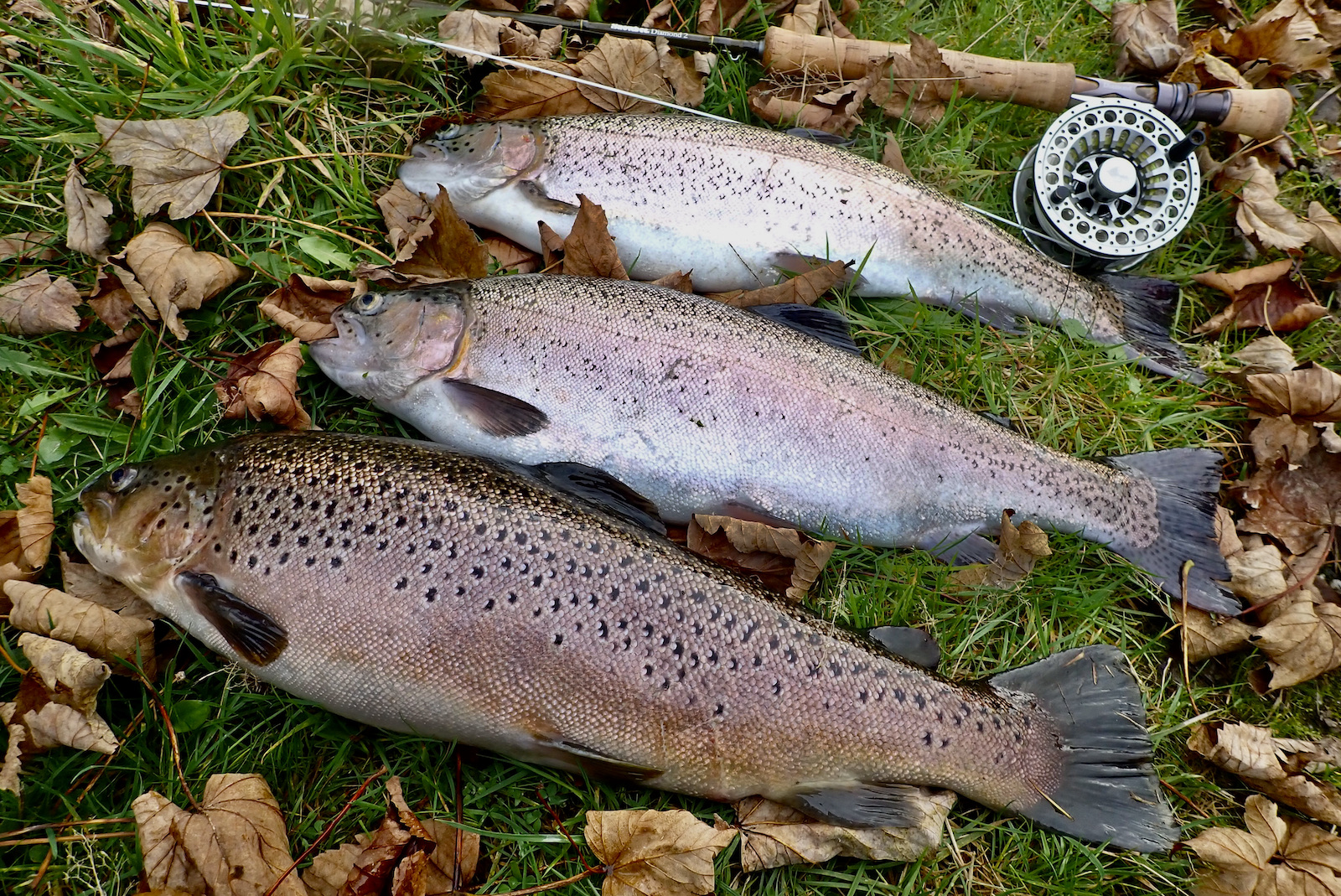
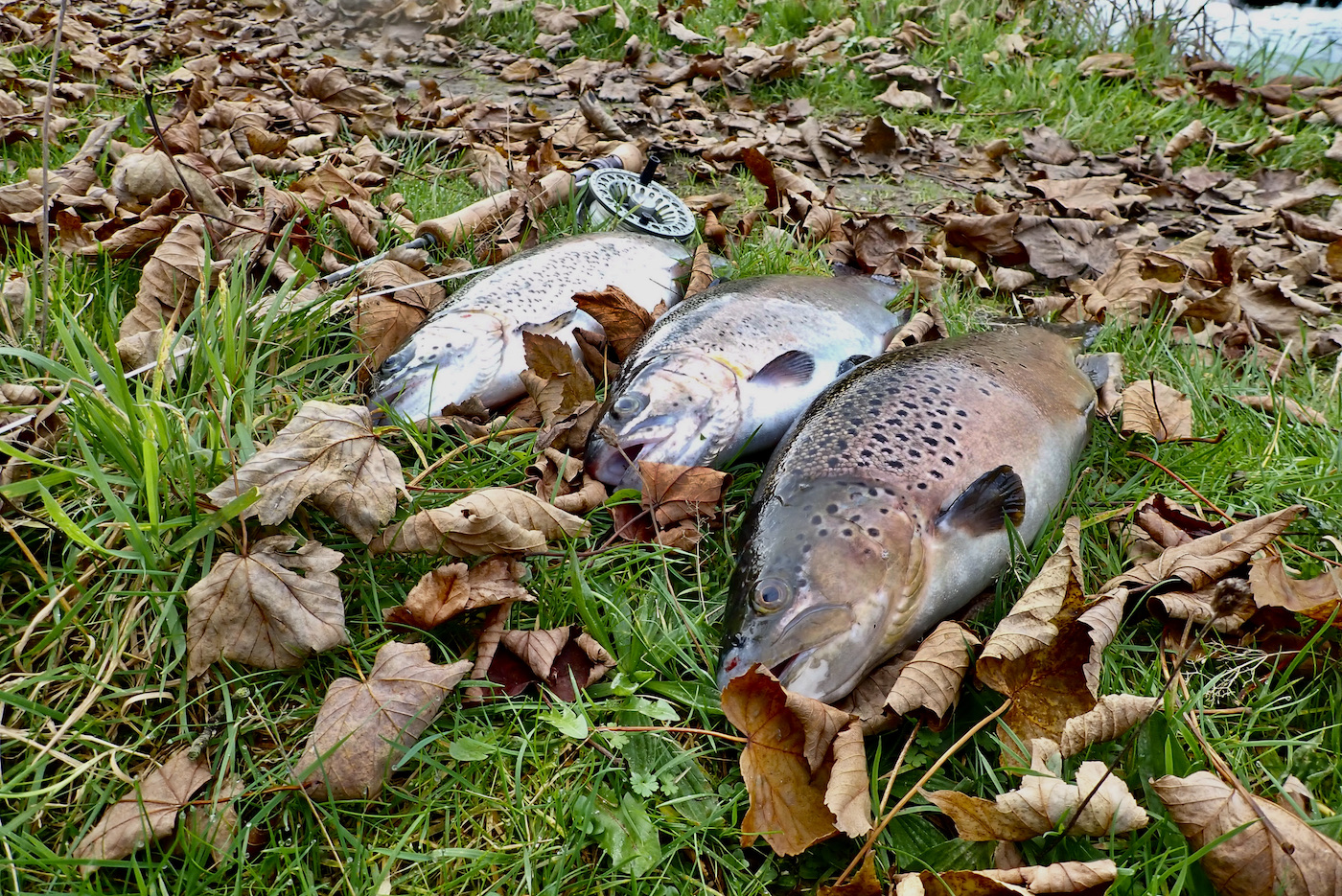
I took the opportunity to have a walk around the lake and capture action and images of the day.
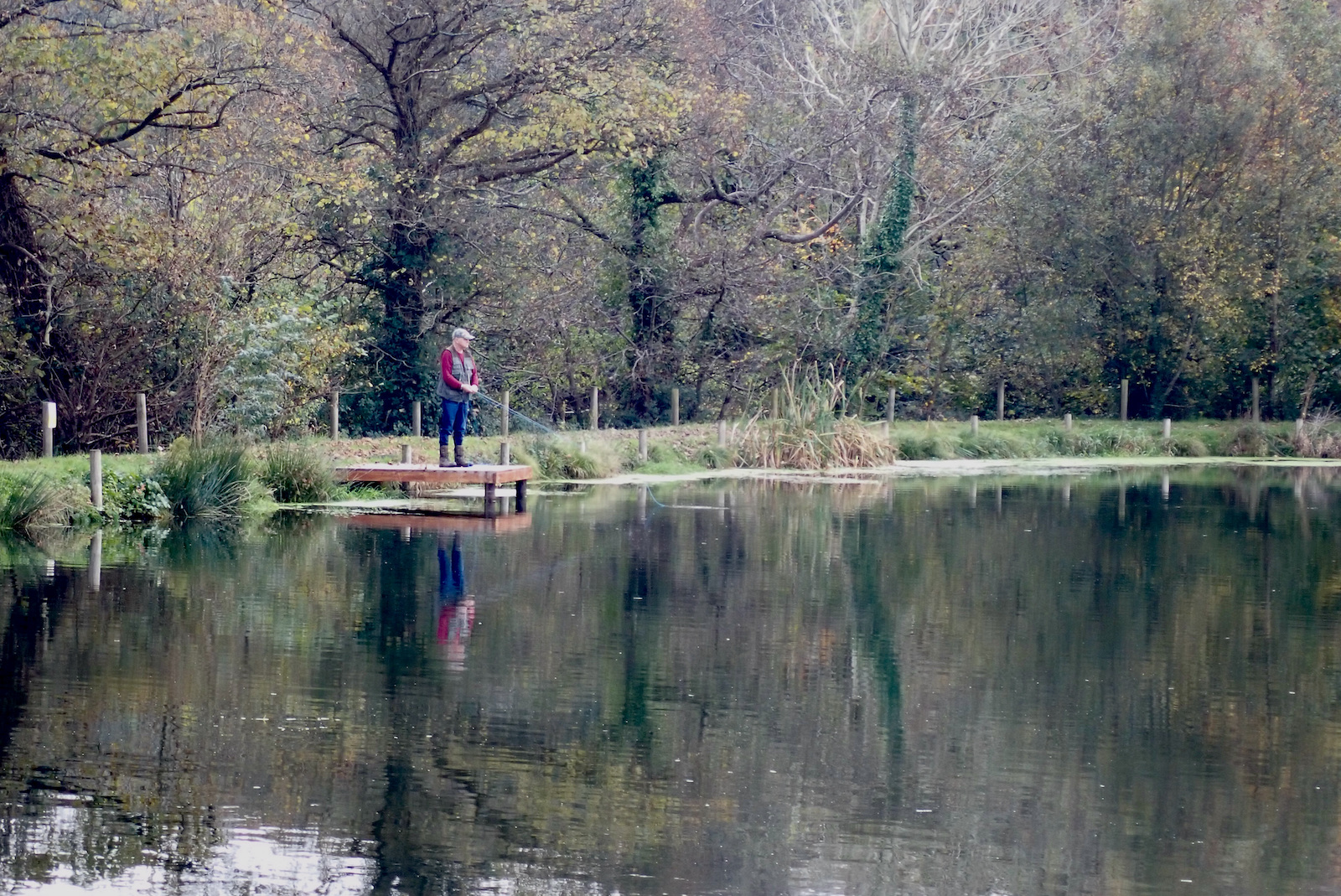

Andrew Facey had enjoyed a good morning banking three good rainbows to 6lb along with a stunning brown trout of over 4lb.

Whilst we chatted Andrews friend Chris Dunn tempted a fine rainbow of 5lb 8oz. The successful fly a slow sinking daddy long legs pattern.


Close to the lakes inlet Graham Snowdon and Grant Jefferson were enjoying good sport completing their limit bags by midday.

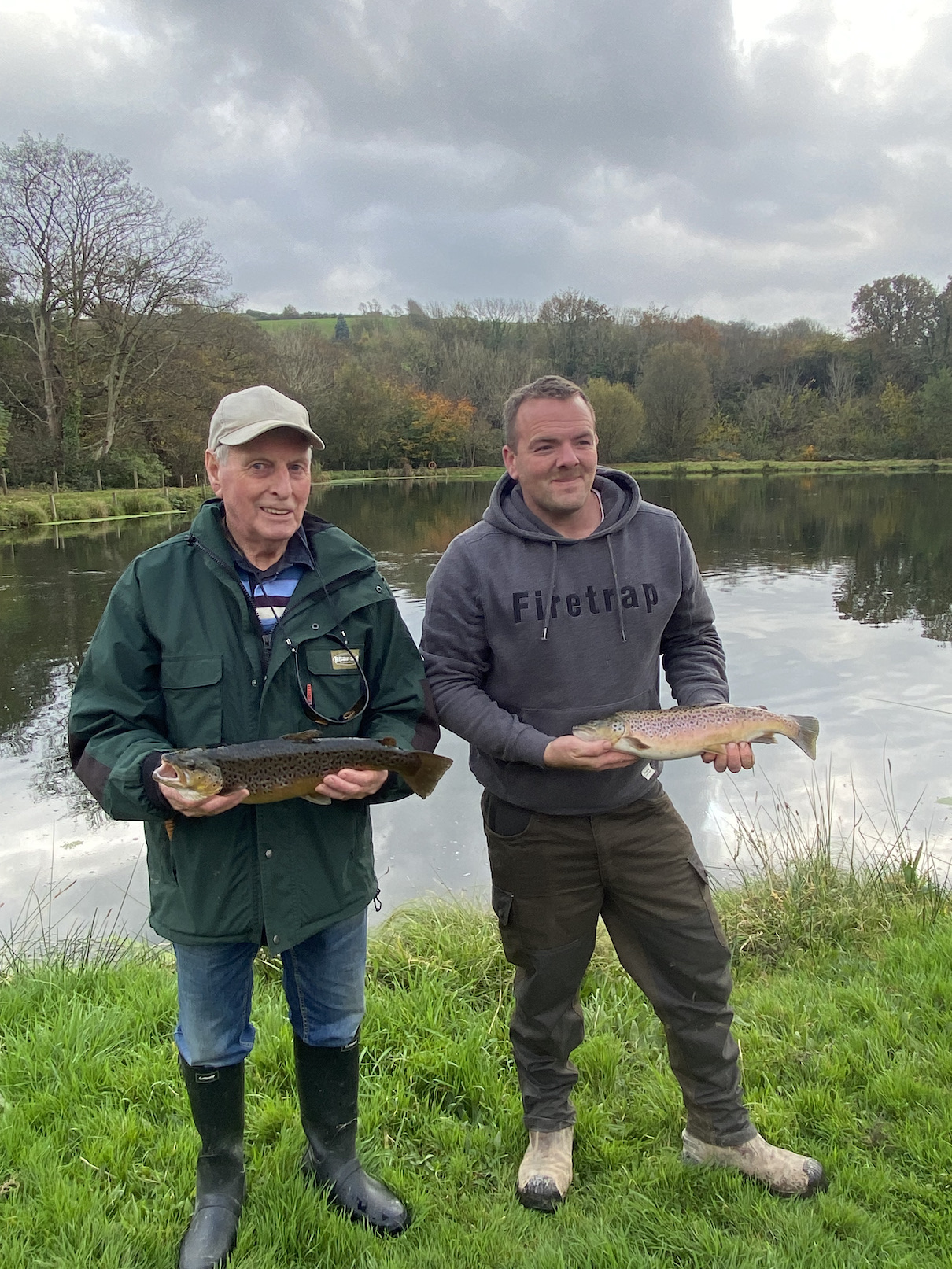
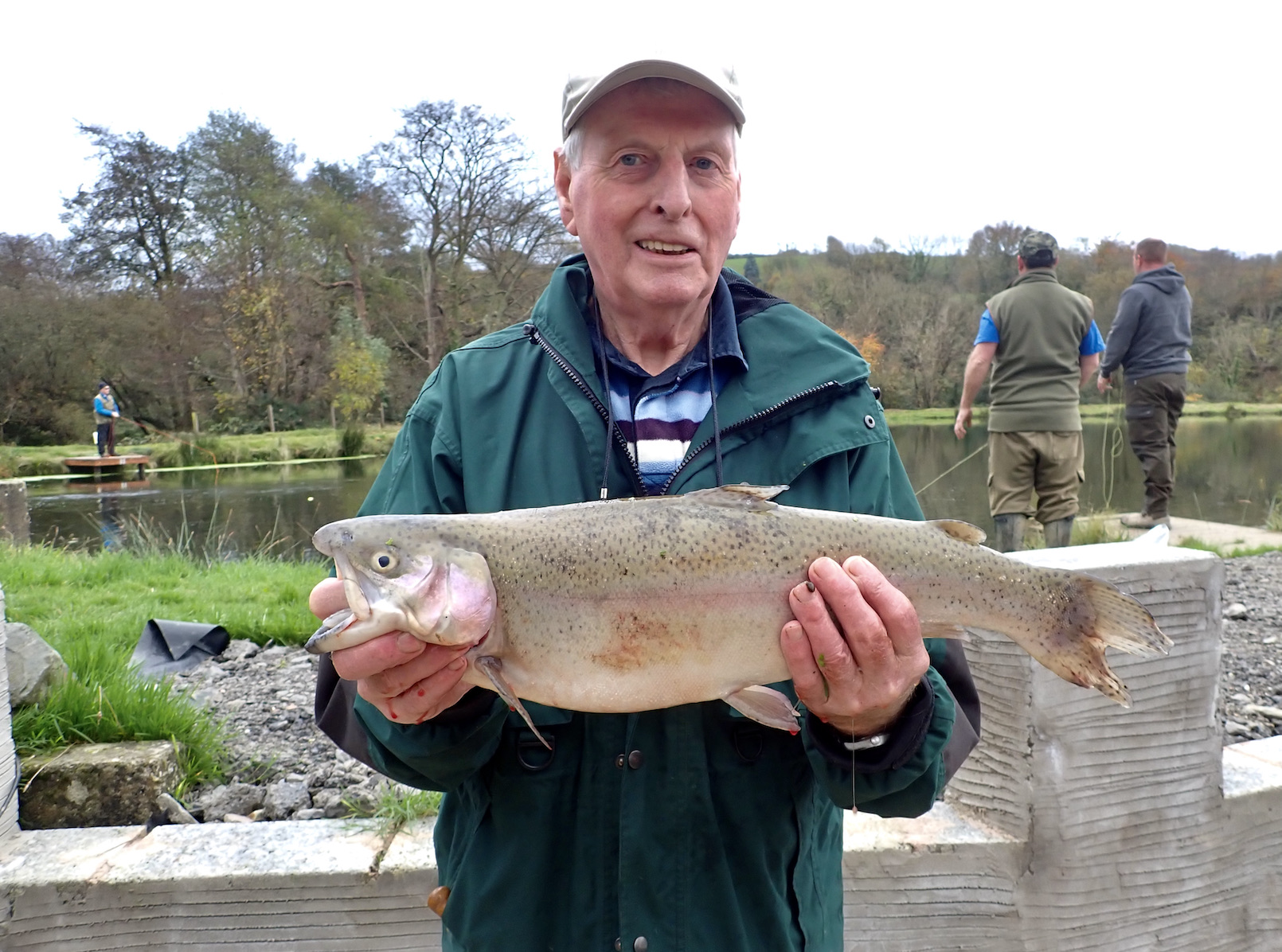
My fellow Wistlandpound Club members were all enjoying good sport with some hard fighting brown and rainbow trout. It seemed as is often the case that a wide variety of fly’s and lures had tempted the lakes trout. Black and green Vivas, cats Whiskers, and damsel nymphs amongst the successful offerings.
The competition weigh in was as follows : –
Dave Mock – 3 trout – 11lb 10oz Best a brown trout of 6lb 3oz
Andre Muxworthy – 3 trout – 11lb 10oz Best trout – Rainbow Trout 5lb 5oz
Wayne Thomas – 3 Trout – 9lb
Colin Combe – 3 Trout – 7lb 15oz


A welcome facility at the lake is a sink, running water and cutting board permitting anglers to gut and clean their catch before returning home.
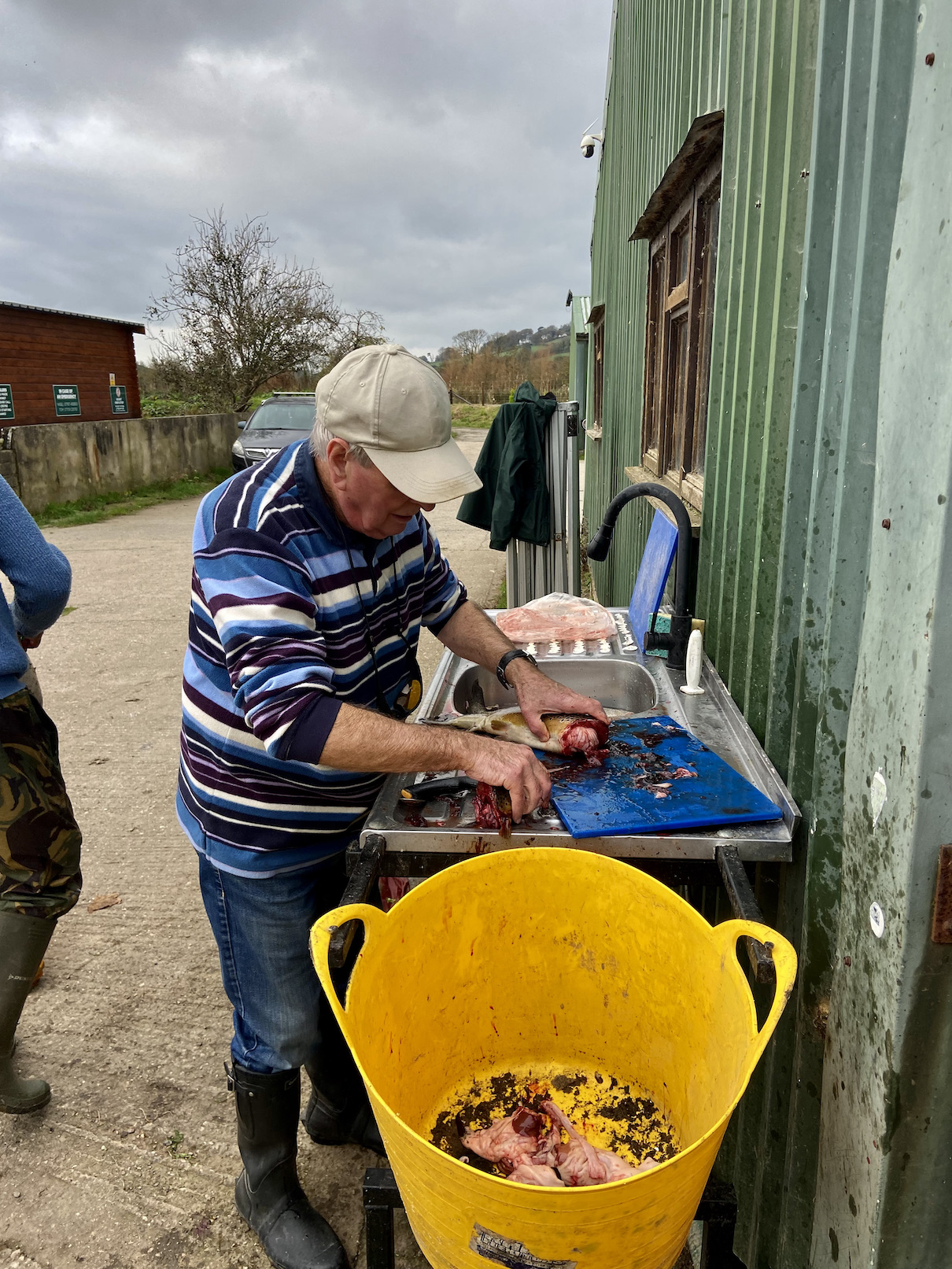



The first weekend of November brought the 2024 season to a close for most Charter boats operating out of Ilfracombe. The calm weather resulted in a good end to the season. Last weekend Bluefin Charters, Predator 2 and Carrick Lee all had successful trips with tope to 42lb boated with several large fish lost. Bass, bull huss, pollock, scad, conger, wrasse, whiting and dogfish were caught and the trips were even more made memorable with sightings of porpoise, seal and tuna.
A quick report from Edward Rands on the clubs last sea trip of the season from Ilfracombe.
We set sail from the harbour at 07:30, early enough for me!, but the days are shorter now.
Our destination was Lundy, about 90 minutes later we were there jigging feathers and retrieving all sorts of plastic lures and began catching mainly pollack with a few wrasse now and again. Although the weather was overcast we were on the west side in some shelter from the easterly wind.
We drifted various marks and then decided to anchor for a while to finish the day off where we caught a little conger, some bull huss and a couple of scad which were used as bait and helped Chris Allin catch a 42lb tope which will take the Tope cup.
The shout was reel in and we headed home with a bucket full of pollack fillets which we shared around. The journey home was quite lumpy with wind against tide but everyone managed and no motion sickness occurred.
The list was
40 pollack to 5lb
6 ballan wrasse
3 scad
4 pouting
10 huss to 10lb
1 strap conger
1 tope 42lb

A very enjoyable day out with plenty of fish, good company and good banter.
Thanks to John and Ted for looking after us again on “Bluefin” and everyone else for supporting the cause.


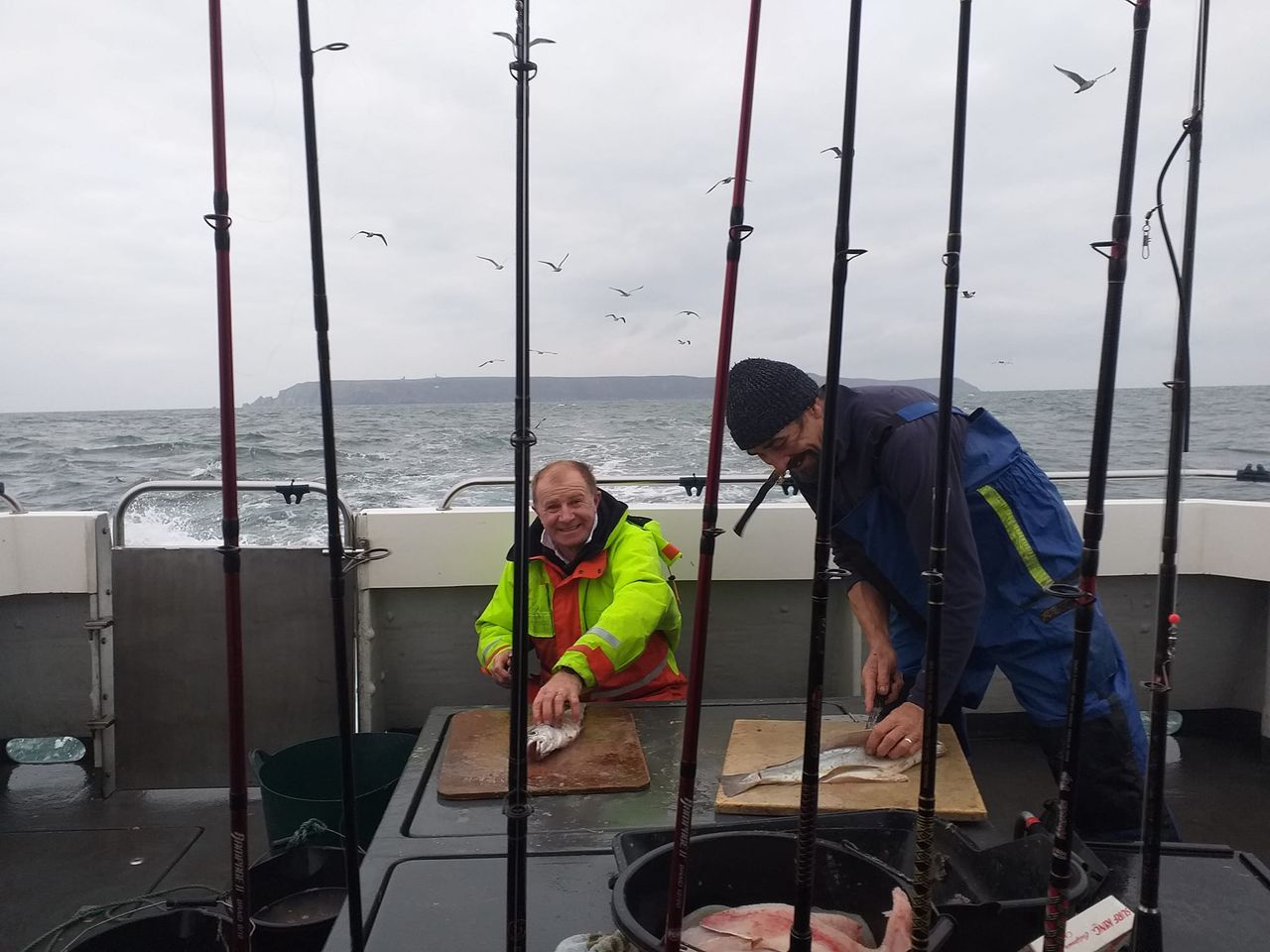


I enjoyed the last trip of the season on a mates trip on Predator 2 skippered by Dan Welch relishing a last chance to explore the reefs and deep channels West of Ilfracombe.
Big tope and big bass were on our agenda though it was good to be out fishing once again whatever we managed to catch.
The sea was calm as we left Ilfracombe just a light Easterly blowing down the channel. The grey November sky was mirrored by the sea the North Devon cliffs dark and sombre as we watched familiar landmarks pass by.

We explored close to the rocky shore at first casting lures to be rewarded with a few hard fighting pollock and wrasse.

With the tide easing Dan suggested we get out and drop the anchor in hope of a big late season tope or ray.
We soon reached our intended mark and a variety of baits were sent down onto the sandy ridges that have a reputation for tope and ray.
I had baited with a mackerel head and guts impaled on a 6/0 Sakuma Kong Hook with heavy wire trace. To my surprise after just a few minutes I felt a savage tug. I let out a few yards of slack and waited until the rod tip pulled over before leaning back into the fish. The rod hooped over and line was ripped from a moderately tight drag. I held on relishing the battle confident in my tackle as whatever had taken the bait started to accelerate away. Suddenly without warning the rod tip sprang back and I felt deflated knowing that I had lost contact with something special. I reeled in to find that the fish undoubtedly a big tope had come off.
Heartened by this we all fished on expectantly catching a succession of small huss and dogfish before the tide eased.
Dan suggested moving further out into faster tide to fish a channel between rocky reefs.
The anchor went down once again and fresh baits were sent down. For the next two hours a steady stream of decent huss and conger ensured regularly bent rods typical of Bristol Channel reef fishing. I also lost a large fish after a very brief connection.






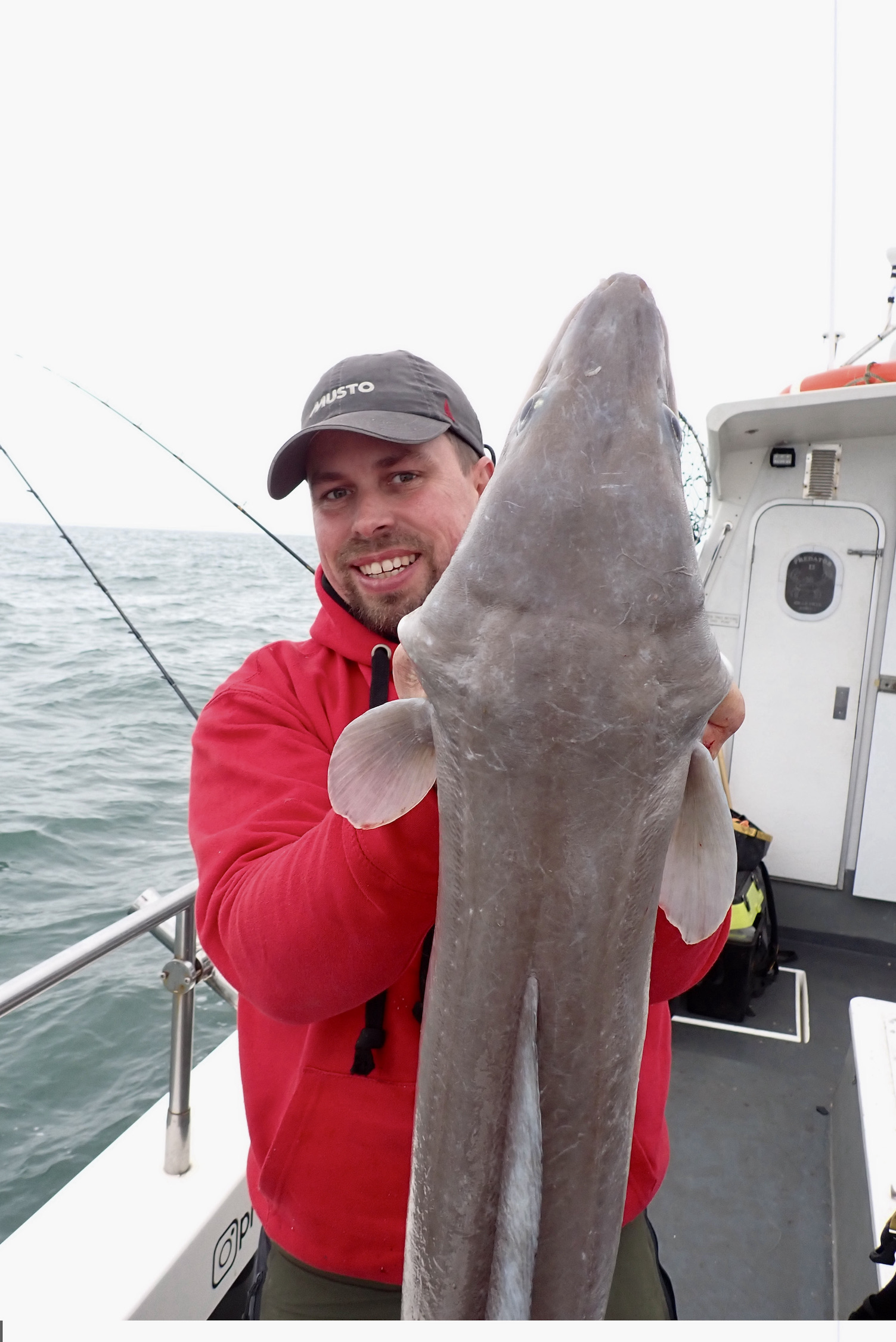
When the tide strength demanded close to 2lb of lead to hold bottom we headed back close inshore to search a tide rip for bass. Here we enjoyed an hours great sport with bass, pollock and wrasse falling to lures the black fiiish minnows bringing most success.


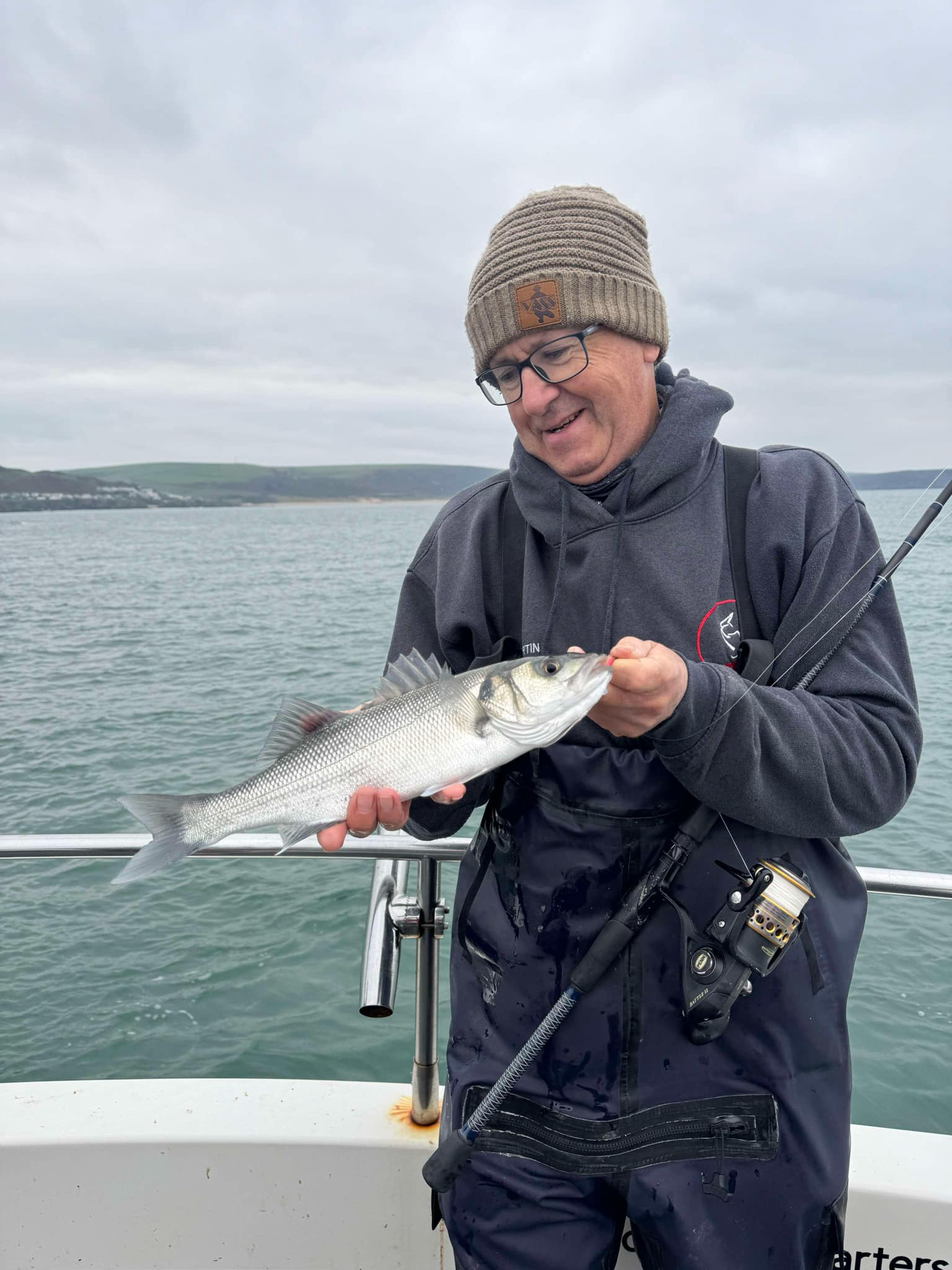

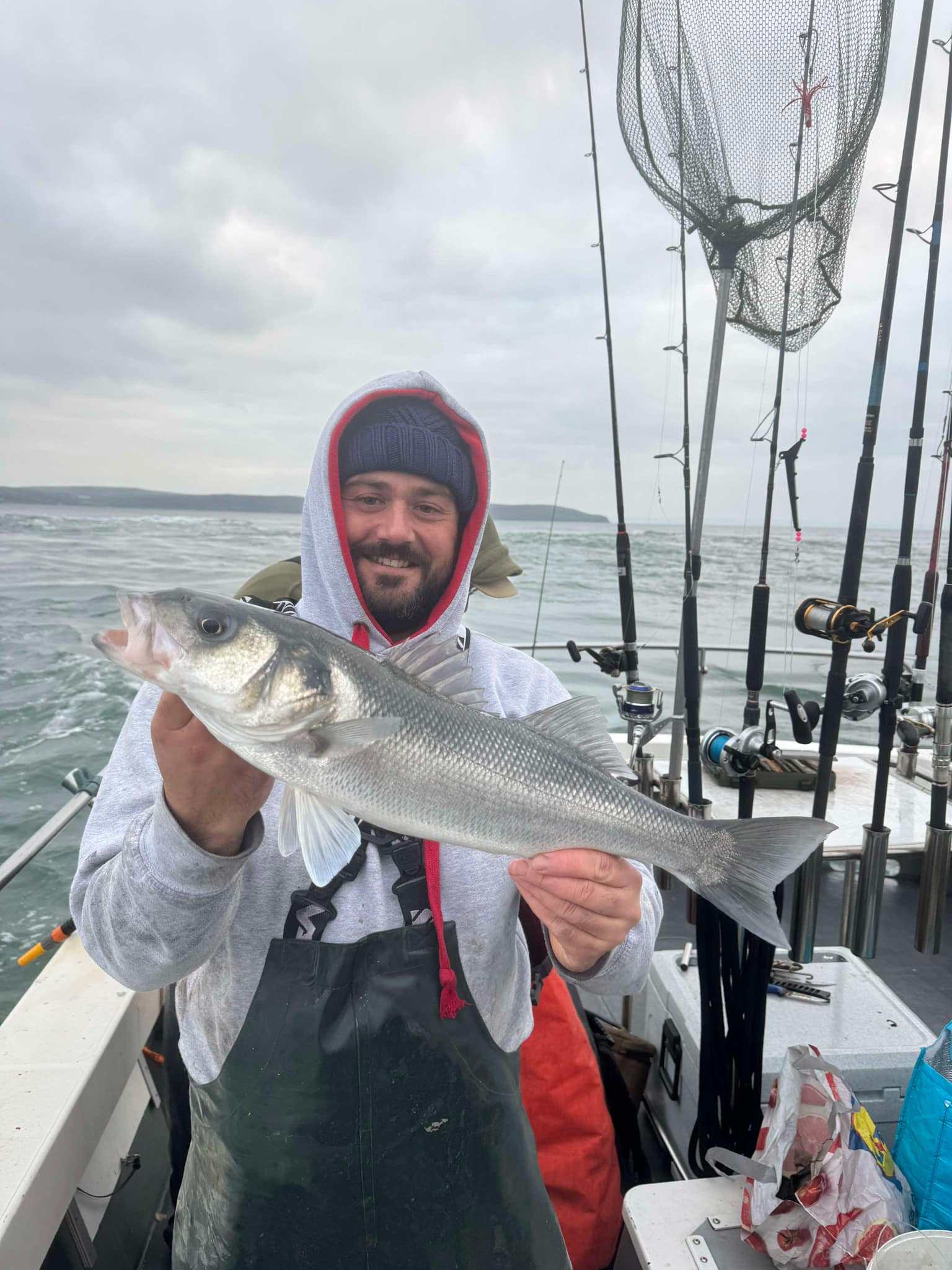

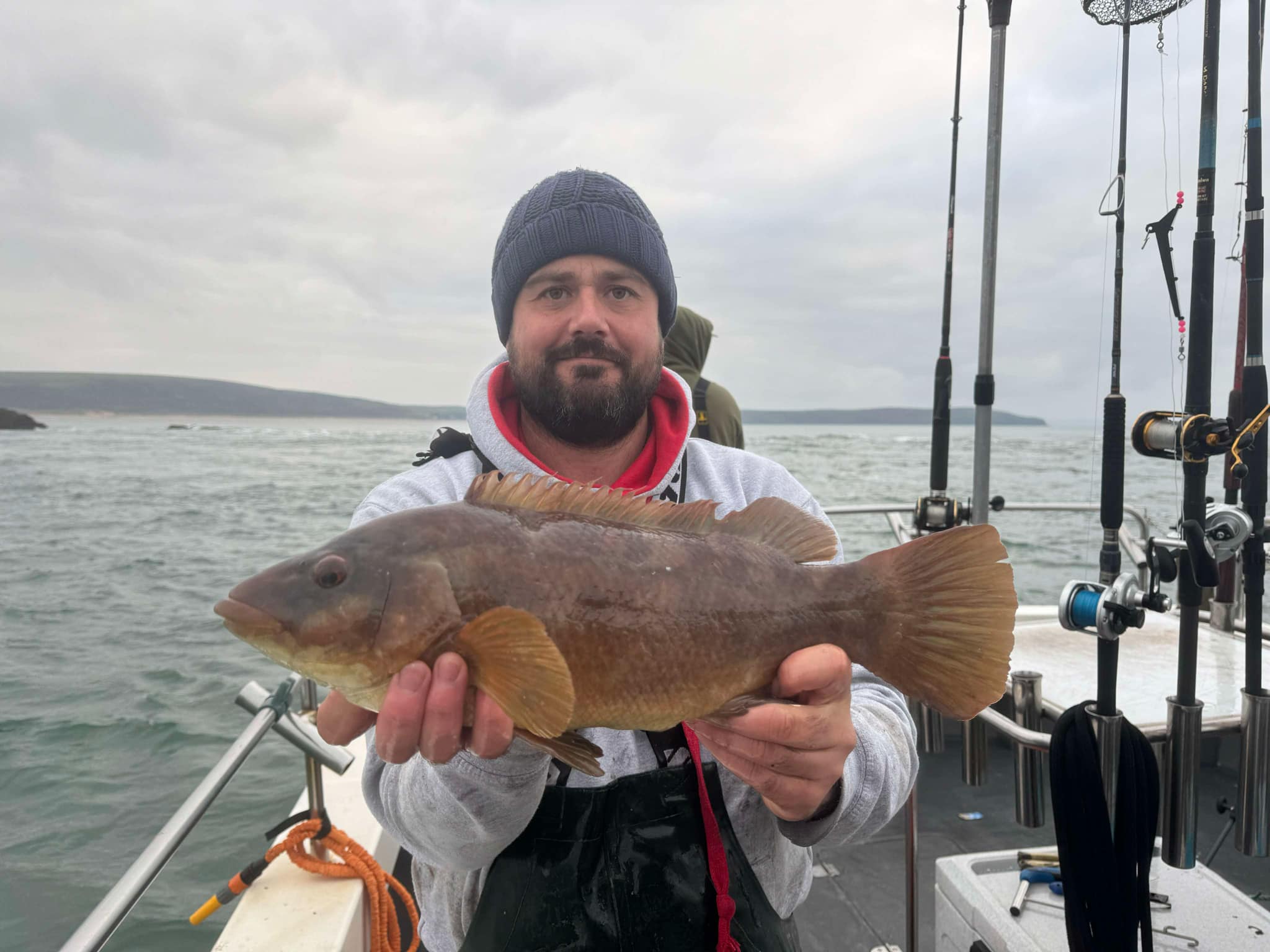



We headed back to Ilfracombe against a lively sea driven by the East breeze. Pollock were filleted along with a couple of good table sized bass. We all chatted about more trips next year with plenty of excursions planned for 2025.


October 2024
Cooler temperatures and some heavy rain have meant that the fish are generally more eager to feed, with improved catch rates. Levels have started to rise, but this is dependent on the catchment and demand – some reservoirs are now full, while others are still only at around 50% capacity at time of writing.
Fishing:
Kennick – The fishing continued to improve over the month, with rod averages up to 3.7 fish per visit. Fish have been well dispersed around the lake, with the Narrows and East Wall regularly appearing on catch returns. Trout have been caught at most depths, from the surface (Foam Beetles, Dry Sedges and Black Gnats), subsurface (Damsels, Hares Ears, Montanas and Blue Zulus), and in the deeper water (Black Boobies and Bloodworms). Chris Illet (from Newton Abbot) caught four rainbows using a small pink Booby and Sedgehog patterns while fishing a fast sink-tip and short leader in the shallows around a weed bed, and noted that fish feeding on fry along the west bank. Graham Roberts caught three rainbows to 2lb 8oz, finding fish rising to dries, as well as getting pulls and knocks from both sub-surface and deep-fished methods.
Siblyback – The fishing at Siblyback dramatically improved over the month, with anglers averaging just under five fish per rod. Crylla, Two Meadows, Stocky Bay and West Bank proved to be the most productive locations, with fish feeding either from or just below the surface, and floating line tactics working well. Dry Foam Beetles, Daddy Longlegs and Sedgehogs caught surface-feeding fish, while deeper fish were caught using Montanas, Black and Yellow Buzzers and Black Snakes fished with a slow retrieve. Keith Burnett (from Newquay) caught fifteen rainbows to 2lb 8oz, and lost one much larger fish. Mick Dodkins (from St Germans) caught five rainbows to 2lb 8oz using a Cats Whisker on a slow intermediate line from the bank at Two Meadows. Ron Wilday (from Liskeard) caught two rainbows at 2lb, using a Blue-Tip PTN while fishing in Crylla Bay. Water levels are 75%.

Burrator – Anglers averaged 3.8 fish per visit, with Longstone, Pig Trough, Boat Bay and Lawns all proving popular. Intermediate or floating lines with a long leader produced the best results, with fast, slow, and ’figure of eight’ retrieves all catching fish. Surface feeders were caught on Daddy Longlegs and Sedge patterns, while deeper feeders succumbed to Damsels, Buzzers (there were active buzzer hatches throughout the day), PTNs and Hares Ears, or lures such as Blobs and Cats Whiskers. Gordon MacLeod (from Tavistock) caught four very fit rainbows to 3lb 4oz on an intermediate line, while Roger Prout (from Pensilva) caught ten rainbows to 2lb 12oz, using a floating line and varied retrieve. Alan Lawson (from Plymouth) caught seven rainbows to 1lb 12oz, casting a dry Daddy to rising fish at Longstone before the rain came, and then a pulled nymph at the top of Narrator Bank. Water levels are now up to 77% capacity at the time of writing.
Stithians – Water levels are at 56% capacity. Anglers averaged 1.5 fish per visit, with most fish being caught from the banks at Yellowort, Pipe Bay, Hollis Bank, Goonlaze and Deep Bank. Generally floating line tactics have been most successful, with fish taking Dry Daddies, Black Hoppers, Black and Peacock Spiders fished in the surface film, Soldier Palmers and Black Pennels.

Fernworthy – Water levels have risen rapidly to 100% over the month, with plenty of fish rising to Craneflies and Sedges. Anglers averaged 1.8 fish per rod, with many taking dry sedges and Black Gnats, as well as Pheasant Tails, Damsel Nymphs, Bibios and Connemara Black. Feeding fish were well spread out, with trout being caught from the East Bank, North Bank, by the dam and by the permit hut. Daniel Robson (from Tavistock) caught a bag of nine nice browns to 1lb using small nymphs fished fairly statically.

Colliford – Here the excellent sport continued, with anglers averaging up to 6.5 fish per rod in one week. The east bank, bank by the dam, Redhill Down, Stuffells and Browngelly proved to be the best locations, with floating-line tactics catching fish feeding from the surface or just below. Foam Daddies, Black Hoppers, Parachute Adams and Foam Beetles all caught rising fish, while sub-surface feeders were caught on pulled Soldier Palmers, Bibios, Zonkers and Damsels. Dean Boucher (from Gunnislake) caught sixteen browns to 16” using pulled Soldier Palmer, Bibio and Zonker patterns; Chris Brand (from St Austell) caught four browns to 16” using a Bibio Hopper, with fish rising to hatching buzzers, sedges, and damsels. Water levels are now just over 70%.
Roadford – The fishing continued to improve, with weekly rod averages up to 4.5 fish per angler. South and East Wortha, Davey’s Bank and North Goodacre produced the best sport, and, with fish rising to hatching buzzers, dry Daddies and Hoppers tempted surface feeders; otherwise, deeper fish were caught using Black Tadpoles, Hares Ears, Soldier Palmers, Zulus and Claret Buzzers. Dean Boucher (from Gunnislake) caught nine browns to 1lb using pulled wets (Soldier Palmer, Zulu and Black Tadpole). The water level is now at 88%.
Please see the Trust’s website (www.swlakestrust.org.uk/trout-fishing) for more information on buying tickets, boat availability, booking and end of season dates. The Brown Trout waters closed for the season on 12 October.
Chris Hall (October 2024)

